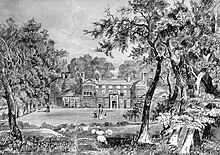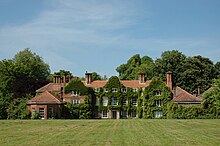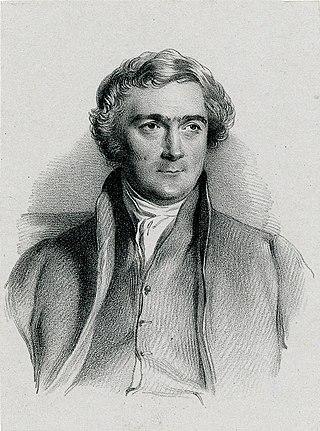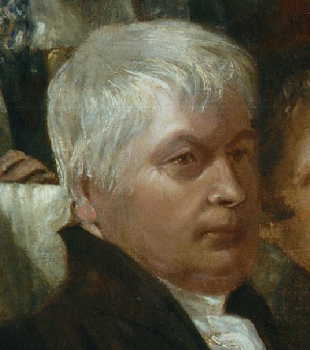History
In the 17th century, John Gurney (1655–1721) left his home town of Maldon for Norwich to live and work among the Quakers of the city. Arriving there in 1667, he became active in the woollen trade. In 1687 he married Elizabeth Swanton (died 1727) of Woodbridge, by whom he had eight children. He died as a wealthy man in 1721, and was buried in "the old Dutch garden that the Friends had bought as their burial ground, the Gildencroft or Buttercup Field", on the land Gurney had received to tend when he first arrived in Norwich. [3] His sons John (1688–1740) and Joseph (1691–1750) continued in the woollen trade in St Augustine's Street and Magdalen Street, respectively. Both married and had numerous children.[ citation needed ]
The younger John Gurney's sons, John (1719–1779) and Henry (1721–1777), gradually added banking to their woollen trade. In 1770 they entered into partnership and formally established Gurney's Bank at 35 Tooley Street (now Pitt Street) in Norwich. [4] When Henry died in 1777, he was succeeded by his son Bartlett (1756–1802), [4] who also took over his uncle John's responsibilities and moved the banking business to Redwell Plain (now Bank Plain), Norwich. [5] The Quaker bank became renowned for its honesty, reliability and fair dealings, so that many people entrusted it with their money for safekeeping. Bartlett Gurney was married twice, but died childless at Coltishall, Norfolk, in 1802. He was succeeded in control of the bank by Richard (1742–1811) and John Gurney (1749–1809), grandsons of Joseph Gurney (1691–1750).[ citation needed ]
Royal links
Prince William Frederick, Duke of Gloucester, a staunch advocate of the abolition of slavery and the reform movement, was a regular guest at Earlham Hall in the 1790s, as was fellow abolitionist Amelia Opie whose husband John had painted the Duke's portrait. Louisa and Richenda Gurney wrote glowing accounts of the Duke in their journals, describing him as sociable and agreeable. [6] [7] [8]

Barclays
Richard Gurney married a daughter of David Barclay, another Quaker merchant and banker. Their six children included Anna Gurney, an Old English scholar, and Hudson Gurney (1775–1864), who later inherited wealth from his father and acted as the head of the Norwich Gurney family. He became MP for Newtown, Isle of Wight in 1816, a Fellow of the Royal Society in 1818, and High Sheriff of Norfolk in 1835. [9] He resided at Keswick Hall near Norwich and in St James's Square, London, but stayed childless.


John Gurney (1749–1809) and his wife lived at Earlham Hall in Norwich, which they rented from the Bacon family. Several of their 13 children died young. The survivors included the bankers Samuel Gurney (1786–1856) and Daniel Gurney (1791–1880), the social reformers Elizabeth Fry and Joseph John Gurney, and the artist Richenda Cunningham. [12] Hannah married Sir Thomas Buxton. Another sister, Louisa Hoare, wrote on education. The 19th-century Gurney family came to personify wealth: Gilbert and Sullivan's 1875 comic opera Trial by Jury has the Judge relate how his wealth increased until "at length I became as rich as the Gurneys." [13]
On John Gurney's death in 1809, his son Samuel assumed control of the Norwich Gurney's Bank. About the same time, he took over the London billbroking business of Richardson, Overend & Company, whose later name was Overend, Gurney and Company. It became the world's largest discounting house for 40 years, but failed – ten years after Samuel Gurney's death – in 1866 with liabilities of £11 million. This failure ruined a number of the Gurneys and many other investors. Gurney's Bank in Norwich, however, escaped major damage to business and reputation from the collapse. [14] The Times "understood that the suspension of Overend, Gurney & Co will not in the slightest degree compromise Gurney's Bank of Norwich. That establishment recently passed into the hands of new partners, whose resources are beyond all question." [15]

Gurney's Bank in Norwich was at that time in the hands of Samuel Gurney's brother Daniel, and of Joseph John Gurney's son John Henry Gurney Sr. (1819–1890). The latter had inherited the bulk of Hudson Gurney's fortune in 1864. [9] He later made a home at Northrepps, near Cromer, where he pursued ornithology. His son, John Henry Gurney Jr., also an ornithologist, and his great-great-grandson, Henry Richard Gurney of Heggatt Hall, continued that tradition. Besides managing his banking business, Daniel Gurney served as High Sheriff of Norfolk in 1853 and took an interest in archaeology and genealogy. In 1848 he printed privately in two volumes an elaborate Record of the House of Gournay, adding a supplement in 1858. Daniel Gurney was married to a daughter of William Hay, 17th Earl of Erroll, and lived near North Runcton, Norfolk.[ citation needed ] Their son Charles Henry Gurney (1833–1899) graduated from Trinity College, Cambridge, and married a daughter of Henry Thoby Prinsep. Later he became a partner in Saunderson's Bank, London. [16] The Gurneys remained active in banking until 1896, when eleven private banks controlled by Quaker families merged under the name Barclays to meet competition from the joint-stock banks. The largest components of this conglomerate were Barclay Bevan Ransom Tritton Bouverie & Co., of Lombard Street in the City of London, Backhouse's Bank and Gurney's Bank.[ citation needed ]
Many of the Gurney family are buried in the Gildencroft Quaker Cemetery, Norwich, some in Keswick All Saints churchyard and some in Intwood churchyard, both near Norwich.[ citation needed ]














